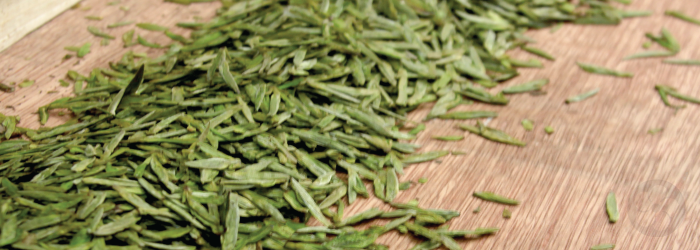A Brief History of Longjing Tea

Longjing, literally translated as "Dragonwell", is now one of China’s most famous and storied teas. Like other whole leaf styles, the pan-roasted green tea, or something like it, was probably first made during the Ming Dynasty, when powdered teas went out of fashion among members of high society. But it was not until the reign of the Kangxi Emperor, in the later Qing Dynasty, that longjing tea was deemed worthy for imperial tribute and ultimately, international fame.
The Perfect Terroir
Though longjing tea as we know it today was not well-known until the early 1700s, the area where this unique style was developed has been making critically acclaimed green teas since at least the Song Dynasty, when Lu Yu mentioned the region in The Classic of Tea. Hangzhou, and specifically the area around Xihu (West Lake) is known for a mild, temperate, and often rainy climate, creating the perfect terroir to maximize flavor.

In the village of Longjing, the name is said to refer to an auspicious local well, where the swirling of rainwater with particularly dense groundwater gives the impression of dragons beneath the surface. This village is easily the most famous location for growing the tea of the same name, but Dragonwell production dominates the entire mountainous region surrounding West Lake.
Tribute Tea
The best known legend of longjing tea tells the story of the Qianlong Emperor, who visited Shifeng Shan ("Lion Peak Mountain") near West Lake and was enamored of the local tea style. One story tells how he returned to his ailing mother’s bedside with a sleeve full of fresh leaves, which were so fragrant she had them brewed immediately. He later conferred imperial status on 18 tea bushes planted in front of a temple on Lion Peak Mountain, reserving all the tea harvested from them for imperial use.

After the collapse of the Chinese monarchy in 1911, the list of Imperial Tribute Teas was rebranded as “China’s Famous Teas” to reflect their new accessibility. Longjing got another reputation boost from Mao Zedong, who liked the style so much that he served it to Nixon during his visit in 1972. Today, Dragonwell tops the list of famous teas, with top grades from well-known farms fetching astounding prices among the Chinese elite.
Authenticity and Imitation
With worldwide fame, demand for this unique style has quickly outpaced the capacity of traditional production areas in the Hangzhou area. Purists may search for farms in the particular micro-climate of West Lake, but longjing tea is now made throughout Zhejiang province, and even beyond.

Despite the draw of traditional terroir, the economic success of Xihu has grown the urban area, while traditional villages like Longjing are beset by eager tea tourists. Our favorite examples of modern Dragonwell come from high elevation tea gardens in the mountains surrounding Hangzhou, where pollution is less prevalent and quality is valued over quantity. Sipping a spring harvest from one of these natural farms, it is easy to understand the lasting popularity of longjing tea.
Sign up for our newsletter to get blog updates in your inbox!



Comments on this post (0)